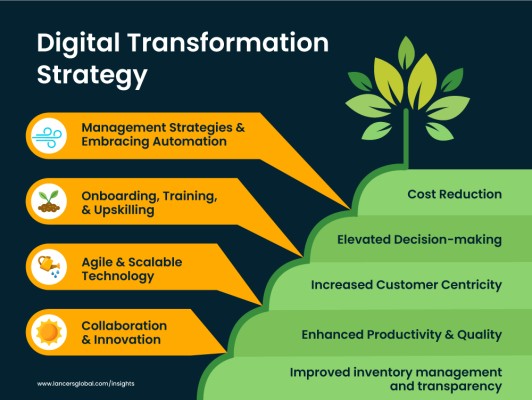What is Digital Transformation Strategy & Why do Manufacturers need one?
In this ever evolving digital era, where technology and digitisation have gained the primary importance in the decision making process of business leaders, it is imperative for them to have a robust IT strategy to survive and thrive in the market.
If we get to ask how manufacturing units - big or small- are coping with this transformation wave? The answer to this question lies in the fact that only 7% of the Digital Transformation Initiatives in the manufacturing industry are navigating to meet objectives. This calls for the need of a value-driven strategy that comprehensively narrates the story of digitization for the organisation.
It is the strategy only that can enable manufacturing leaders to succeed in the present and shape the future. To improve business performance and enhance efficiency, digital transformation practices can help them attune to the changing business needs, empowering them to stay ahead in the manufacturing industry.
As Digital Transformation Strategy enables the business to leverage the technology to attain its objectives, it is important for us to understand the Digital Transformation Strategy and its elements in detail so that the same can be applied in a manner that yields results and drives operational excellence in the manufacturing industry. Let's explore the essential IT strategy components and implementation process.
What is Digital Transformation Strategy?
A digital transformation strategy is a process to revamp the business by integrating technological innovations into the appropriate areas in order to achieve a variety of goals, such as increased productivity and collaboration as well as faster delivery and higher customer satisfaction.
One particular roadmap cannot qualify as transformative; instead it refers to steps taken to assure long-term success of enterprise which alongside enables it to compete more effectively in the digital marketplace, evolve with the times, and offer more value to customers.
Why is the Digital Transformation Process crucial for Business?
A strategy for digital transformation outlines how an enterprise might use industry 4.0 innovations to add value, enhance the customer experience, and spur expansion. Its objective is to assist organisations in remaining competitive while keeping up with the rapidly evolving digital enterprise landscape.
Enhanced Efficiency: Discarding manual labour and repetitive operations, integrating digital transformation, and using ideal and immersive technologies can lead to increased productivity. The process, combined with an efficient workflow, enables the team to operate more efficiently by automating manual procedures and processing information throughout the firm.
Seamless Customer Experiences: Thinking that digital transformation can only increase team productivity is a mistake. Streamlined, intuitive experiences across a variety of channels and touchpoints for your customers result in increased customer happiness, loyalty, and advocacy. This includes everything from email communications to user portals and digital products, as well as the frequency with which you contact new prospects, which may ultimately spur revenue growth.
Increased Agility: Businesses become more nimble as a result of digital transformation. By learning from the world of software development, we can increase our agility through digital transformation, which directly affects the market, customers, and competitive landscape. This creates a faster environment for invention, experimentation, and innovation and increases adaptability while also opening the door to advancement.
Drive Innovation - By fostering an atmosphere that favours experimentation, the adoption of new technology, and a culture of continuous improvement, digital transformation strategies can assist promote innovation and unlock new opportunities for growth. Businesses can find new chances for growth and offer cutting-edge products and services to match changing client needs by embracing new technology and utilising data insights.
Outpacing the Competition - By increasing productivity, lowering expenses, and improving the customer experience, a digital transformation strategy aids businesses in staying one step ahead of the competition. Businesses can build more adaptable and flexible business models by utilising new and developing technology. By being able to respond to shifting market conditions and client wants, businesses are better positioned to outperform rivals in the digital economy.
Unlocking the power of Digital Transformation Strategy with 5 essential elements
A digital transformation strategy is crucial for businesses that wish to flourish, develop, and remain competitive in the digital age. With the below elements, organisations can successfully undergo a digital transformation that fosters development, innovation, and competitive advantage:

1. Well-rounded Team
A team with a variety of abilities that can transform an idea into a successful plan is necessary to deploy revolutionary technology. Each effort to implement digital transformation strategy must take culture into account. Before the process can fully take root, the current corporate culture frequently needs to adapt and develop in new ways. A team with the appropriate balance of talents that can be used during the whole lifetime of digital transformation is very crucial for the successful implementation of the process.
2. Vision and Leadership
Digital transformation requires strong leadership and a culture of innovation and agility. The leadership team should be committed to the transformation and willing to invest the necessary resources to make it successful. Those in charge of making decisions must devise innovative strategies for leading and assisting the workforce. Understanding that digital transformation is about encouraging and motivating human change as well as utilising modern technology is one of the strongest points for leaders.
3. Technology Architecture
Technology is a key component of digital transformation since it makes automation, data analytics, cloud computing, artificial intelligence, and other digital capabilities possible. In addition to making sure that they are interoperable and adaptable, the organisation should choose which technological systems and solutions adequately meet its requirements.
You must choose the most advanced equipment, whether you are working to upgrade legacy systems, develop new programmes, or create whole new processes.
4. Process and framework
Business processes and workflows frequently need to be changed in order to increase productivity, decrease costs, and enhance the customer experience. Organisations should identify the processes that require the most transformation and concentrate on putting the changes in place that have the greatest impact.
5. Customer Insights and Experiences
Delivering a great customer experience across all touchpoints and channels should be the main goal of the strategy of digital transformation. This calls for a focus on the demands, preferences, and behaviours of the consumer as well as a customer-centric strategy.
7-step process for crafting a digital transformation plan
- Form a cross-functional team: Assemble a team of representatives from various departments or functions to ensure a comprehensive understanding of the organisation's needs and facilitate collaboration.
- Document current transformation state: Assess the existing technology and evaluate the hardware and software tools used, level of tech enablement, and security processes. Consider external trends and innovative ideas for the future state.
- Conduct analyses: Analyze gathered information to determine IT needs and develop a model of digital operations aligned with business goals, milestones, and KPIs.
- Develop a five-year strategy blueprint: Incorporate flexibility and limit initiatives to 4-7 items to avoid lack of focus.
- Analyse and prioritise initiatives: Prioritise initiatives based on value, cost, and complexity, considering potential benefits and resources required.
- Develop an implementation roadmap and secure buy-in: Include stakeholders and plan execution from concept to implementation.
- Monitor, measure, and revise: Review IT strategy annually or on a rolling 3-year plan to make necessary changes and ensure accountability and transparency.
Why is the Digital Transformation approach a key to staying ahead in the Manufacturing Industry?
In the context of manufacturing, digital transformation strategy is the process that supports an organisation in moving consistently through the automation spectrum and swapping the digital infrastructure and processes for manual activities in order to minimise complexity and misprocessing.

However, digital transformation encompasses more than just tools and technologies; it also affects people, processes, and things. If you are wondering how the manufacturing industry can accelerate its digital transformation, let us explain that the solution is to envision the future and gradually develop the technological and human capabilities necessary to realise it.
1. Enhanced Productivity & Quality
With the incorporation of sensors, automated testing, and quality control measures during the manufacturing process and leveraging the digital transformation process, we can achieve elevated levels of product quality, which directly results in minimising errors and enhancing overall production processes.
2. Cost Reduction
Reduced costs and increased production without affecting quality are the primary goals for any manufacturer. Diagnosing and resolving issues, minimising downtime, and maximising output are the results of adopting digital tools and analytics. It becomes easier to identify potential problems before they occur and plan maintenance during downtime to avoid additional cost.
3. Elevated Decision-making
Digital transformation in manufacturing enables firms to make more informed and precise decisions by visualising and analysing product data in order to improve quality, performance, and efficiency. Additionally, it gives businesses a more accurate view of the market by giving them better insights into consumer behaviour and purchasing power. Obtaining precise and up-to-date information regarding the expense and duration of various processes becomes easier.
4. Increased Customer Centricity
At today’s time, consumers are looking for uniqueness without letting the responsiveness or speed of the product delivery suffer. Working to achieve a customer-centric business is possible with agile manufacturing and production processes, which can be achieved with the successful implication of an efficient digital transformation strategy.
5. Improved inventory management and transparency
Integrating inventory management systems with cutting-edge technologies like IoT, social media, analytics, etc. helps businesses stay current. They can simply trace any piece of equipment and provide correct information about the location, usage, market value, etc. without having to perform manual checks or waste time looking for the data.
How do you implement a Digital Transformation plan for the growth and success of your business?
Legacy systems, privacy concerns, and workforce training are some of the many hurdles that enterprises must get over in order to establish digital transformation strategy successfully. Yet, the advantages of digital transformation surpass the drawbacks, and manufacturing companies must use digital technology to survive in the rapidly evolving world of Industry 4.0. The goal of the manufacturing digitalisation plan is to help businesses become more competitive, efficient, and adaptable in the digital world.
The actions that a company needs to take in order to implement the digital strategy are described in this section, which will ultimately help the organisation in improving the current state and achieve the ideal future condition.
- Deploying agile and scalable technology to facilitate growth and expansion
- Skillfully implementing change management strategies and embracing automation to improve efficiency
- Ensuring effective onboarding, training, and upskilling programmes to develop a highly skilled workforce
- Restructuring the organisation to remove barriers and promote collaboration and innovation.
Essential ways to ensure the longevity of digital transformation practice in manufacturing
Manufacturers must embrace digital transformation to be relevant in the dynamic economy. To achieve this transformation, there must be a culture change, adoption of new technologies, and rethinking of business procedures. For effective digital transformation in the manufacturing industry they need to adhere to a number of essential procedures to not only guarantee a smooth transition but to sustain it in the future as well. They include:
1. Determining their current degree of digital transformation
2. Establishing specific objectives
3. Creating a roadmap
4. Removing obstacles
5. Tracking and evaluating success.
Prior to implementing new technologies and concepts, it is crucial to evaluate the current state of automation, data accessibility, and decision-making abilities. In order to identify gaps, prioritise investments, and lay the foundation for future growth and innovation, it can be helpful to create a roadmap with a schedule, goals, and particular KPIs. Manufacturers must create a strong digital culture and invest in the necessary technologies to overcome implementation challenges like reluctance to change and the use of legacy systems.
It is crucial to evaluate success using metrics like cost savings, customer happiness, employee engagement, and operational efficiency. Making data-driven decisions and tracking progress over time are made easier thanks to this. By taking these actions, manufacturers may preserve their competitiveness in the market while relocating smoothly into a more digital future.
How can Global Lancers help your business plan the most effective digital transformation strategy?
In conclusion, digital transformation is no longer an option but a necessity for manufacturing companies to stay competitive in today's market. The industry is facing increasing pressure to improve operational efficiency, reduce costs, and enhance the customer experience.
Digital transformation is not just about implementing new technologies. It requires a cultural shift, a customer-centric approach, and a skilled workforce in which Global Lancers can prove to be a reliable partner which can also enable their clients to stay relevant and thrive in an increasingly digital environment,
By embracing digital transformation roadmap, we assist manufacturing companies to unlock new business opportunities, streamline their operations, and create more value for their customers. The journey towards digital transformation may seem daunting, but with the right strategy and approach, it can be a game-changer for manufacturing companies of all sizes and we forge strategies to accomplish a seamless transition.
Recent Posts





Tags
-
Digital Transformation



Add Comment
0 Comments